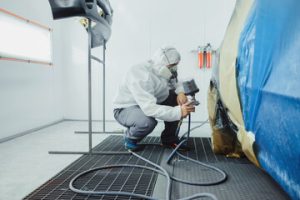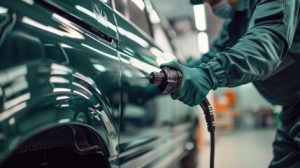Fiberglass repair goes beyond surface touch-ups. It involves structural precision and chemical science. Unlike metal repairs, fiberglass work needs temperature awareness. Resin behavior shifts with slight heat changes.

New-age fiberglass panels are lighter but stronger. They bend under pressure but retain shape memory. This makes repairs more technical. Restoration must respect the original flex profile. Keep reading the article below to learn more about Fiberglass Auto Body Repair.
Micro-fractures are now easier to detect. Repair technicians use polarized light tools. These expose internal stress lines invisible to the eye. It prevents misjudging panel strength.
Eco-resins are replacing older hardeners. They emit fewer fumes and cure faster. These are safer for both the environment and the workers. Repair bays now follow stricter ventilation protocols.
Sandpaper grades have evolved too. Ultra-fine grains are used for pre-paint smoothing. These reduce micro-grooves on gel coats. It ensures a cleaner, glossier finish.
Many fiberglass vehicles now include carbon-weave integration. This hybrid material resists denting but chips easier. Repairs require layer-specific patching. Each weave direction affects resin flow.
Patching is no longer just cutting and laying cloth. New templates use digital cutouts. These match panel curvature with high precision. The fit avoids excess sanding later.
Vacuum-sealing methods are used during curing. They remove air pockets from under the resin. Air bubbles weaken repair sites. This method guarantees stronger adhesion.
Surface temperature is monitored in real time. Infrared scanners are mounted beside work tables. Sudden spikes trigger resin recalibration. Consistency ensures durability post-repair.
Color matching is now done with spectrophotometers. Fiberglass fades differently than metal. Digital readings detect undertones invisible under normal light. This avoids mismatched repainting.
Sanding blocks are now 3D contoured. They fit body curves without warping pressure. This improves feathering along repair edges. Seam lines disappear more cleanly.
Smart resins include curing indicators. They shift color slightly when fully cured. This removes guesswork from sanding timing. It speeds up workflow with less risk.
For marine-style fiberglass builds, salt-resistance becomes important. Auto shops replicate salt exposure with synthetic misting. This checks how the panel responds before sealing. It mimics real-world degradation.
Many shops now isolate fiberglass work areas. This prevents dust from cross-contaminating other materials. Fiberglass dust affects metal parts if not separated. Clean zones increase repair quality.
Hand-laying is being replaced by semi-automated sprayers. These spray uniform resin-and-mat mixtures. Consistency improves, especially in deep dents. Labor strain is also reduced.
Trained technicians analyze crack types. Straight cracks differ from radial fractures. Each one needs a unique layering method. Wrong approaches cause re-fracturing later.
Resin blending is becoming digital. Machines now calculate ideal ratios for humidity and temp. Manual mixing caused inconsistent cures. Technology now eliminates this guesswork.
Some shops pre-warm the panel before patching. Warm surfaces increase resin grip. The bond forms tighter molecular chains. Cold patches tend to delaminate faster.
Scribing techniques enhance bond reliability. Technicians score the surface with micro-grooves. These act like resin anchors. It increases the longevity of the repair.
Special gels prevent resin sagging on vertical panels. These gels hold the resin in place mid-cure. Without them, gravity would distort the repair. Precision is preserved.
UV-activated resins are gaining popularity. They cure under UV lamps within minutes. This speeds up repair cycles significantly. It’s ideal for small-area touch-ups.
For older vehicles, panel matching becomes an art. Fiberglass layers age and discolor. Some techs hand-tint resin for subtle matches. It respects the car’s originality.
Digital logs now track each repair layer. Apps record mat type, resin ratio, and cure time. This archive helps in future inspections. Transparency boosts repair credibility.
Some fiberglass builds have sandwich cores. These layers include foam or honeycomb centers. Repairs need controlled core removal. Improper work weakens impact zones.
Edge-bonding has received special attention. Corners often chip or delaminate first. Reinforced corner layering resists peeling. Shops now add microfibers at these points.
For extreme curves, shops mold support braces. These temporary forms hold resin in shape. Once cured, the brace is removed. It prevents resin pooling in concave areas.
Paint adhesion to fiberglass is often tricky. Surface prep includes anti-static wiping. Static charge repels paint layers. Neutralizing agents now come pre-mixed.
Post-repair testing now uses vibration sensors. They simulate road conditions. Loose patches emit unique frequencies. Repairs are rechecked if irregularities appear.
Multi-axial matting is a trend in reinforcement. It strengthens impact zones from all angles. Instead of one-directional fibers, it includes cross-woven strands. Durability increases significantly.
Panel thickness is digitally measured post-repair. This ensures uniformity across the body. Uneven panels reflect light poorly. Precision keeps aesthetic integrity intact.
Rust isn’t a concern in fiberglass but rot is. Moisture trapped in layers causes breakdown. Shops now use desiccant chambers post-patch. They extract internal dampness before sealing.
Workstations now include humidity domes. These regulate the local air around the patch. Humid air prolongs curing. Controlled bubbles ensure consistent hardness.
Some fiberglass panels include built-in sensors. These detect pressure shifts after impact. Repair technicians use diagnostic readers. It reveals internal strain not seen on the surface.
Tensile tests are conducted on cured panels. They simulate pulling force under stress. If the panel resists expected pressure, it passes. Safety standards are maintained.
Gel coat layering is a skill of its own. Too thick and it cracks. Too thin and color shows unevenly. Trained techs layer it like a painter blends oils.
Before cutting, panels are scanned with digital tracers. This avoids hitting embedded wiring or sensors. These features are common in modern designs. It prevents accidental component damage.
Airbrush blending techniques are used for final coats. It hides transitions from original to new panels. The result looks seamless. Eyes can’t tell where the repair begins.
Fiber dust disposal follows strict rules. It’s non-biodegradable and airborne. Shops now use suction cabinets. These keep air and skin free from irritation.
Mold release agents help in complex shapes. When using panel molds, release spray avoids sticking. It ensures the resin doesn’t bond with the mold. This preserves both tool and patch.
Lightweight filler paste is used on final layers. It sands easier and bonds better. Heavier pastes add unnecessary weight. Fiberglass repair aims to restore, not overbuild.
Digital training modules teach fiberglass repair today. Students use VR to practice patching. It builds muscle memory before touching a real car. It shortens learning curves.
Mat layering now follows a “stress-mapping” guide. High-impact zones get more plies. Light zones get fewer layers. This balances flexibility and strength.
Mobile repair vans carry modular kits. These include UV lamps, digital mixers, and cutting tools. Technicians perform roadside repairs. Convenience is now a market need.
Heat guns are used for post-cure reshaping. Slight warps are corrected without re-patching. It saves time and material. Only trained techs should attempt it.
Color pearls are added to clear coats for shimmer. It gives a factory-quality look. These need careful mixing to avoid blotching. Aesthetics are taken seriously.
Soft-edge feathering has replaced hard-line sanding. It fades the patch into surrounding paint. The repair becomes invisible. Clients prefer this blended finish.
Acoustic dampening is considered in some repairs. Fiberglass panels can amplify road noise. Technicians add internal insulation layers. It improves ride comfort.
Some repair shops offer hydrographic printing. After patching, a pattern is applied via water transfer. It camouflages the patch under a textured design. It’s a blend of art and science.
Overhead LED rigs improve visibility. Shadows distort panel curvature. Bright, diffused lighting shows imperfections. Every flaw is easier to spot.
Customers now receive digital repair summaries. These include before-and-after photos and material logs. It boosts trust and transparency. Documentation is part of quality service.
Fiberglass repair continues to evolve. It’s not just about filling holes or smoothing edges. It’s a science guided by chemistry, design, and innovation. As cars change, so will the hands that restore them.
